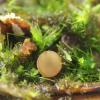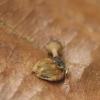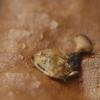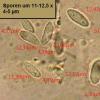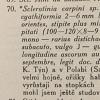
21-12-2025 21:32
Pol DebaenstHello, Garden, Burgweg 19, Veurne, BelgiumOn 10/1

21-12-2025 21:40
Isabelle CharissouBonjour, j'aimerais connaitre les références de

21-12-2025 21:31
Pol DebaenstHello, Garden, Burgweg 19, Veurne, BelgiumOn 10/1

21-12-2025 21:31
Pol DebaenstHello, Garden, Burgweg 19, Veurne, BelgiumOn 10/1

20-12-2025 23:08
Patrice TANCHAUDBonsoir, récolte sur sol sablonneux dans l'arri�

21-12-2025 09:32
Hello.A tiny ascomycete found embedded in wood in

20-12-2025 15:47
Mirek GrycHi.These grew on pine wood that was heavily covere
yesterday we found one Ciboria with the diameter of 0,8 mm on wet sphagnum. Unfortunately wer aren't sure if the seed is from betula or alnus. Birches (betula) were around 30 metres away from the locality, alnus (alders) weren't close. The spores are around 11-12,5 x 4-5 µm, hyaline and verrucose.
Different literature gives different spore lengths for both Ciboria seminicola (=alni) and Ciboria betulae (including the documentations on Zotto's page). Most of the time the described spore lengths are longer than ours. Can someone determine whether the seed is from betula or alnus and the Ciboria has to be Ciboria seminicola (= alni) or Ciboria betulae?
Thanks in advance and best regards,
Jan-Arne

My feeling is, when I look at my folders, that spore shape is different, apart from slightly longer spores in C. seminicola. Your spores fit much better C. betulae. But I have seen very few samples of C. seminicola, so maybe the difference is accidental.
With molecular data the matter of species distinction is not yet explored, I only know of sequences from C. betulae. So whether the two taxa are really distinct is not clear to me.
the possible loss of the seed wings was the main reason why we doubted the safe determination as Ciboria seminicola. Thank you for your opinion that approves these doubts. I'm curious of what future sequence analyses will show.
Vielen Dank und beste Grüße
Jan-Arne

concerning the seed: can Carpinus betulus be excluded? By size it could fit well (using the diameter of the apothecium as a scale).
Here is a random internet picture:
http://info.sotvorenie.kiev.ua/content/family_estate/plants/kinds/trees/carpinus_betulus/carpinus_betulus_big18.jpg
Regards
Martin


Regards
Martin

KLIKA J. E. (1923): Príspevek k ceské mikroflore — III. Cas. Nár. Mus. 97: 95—99

tomorrow I'm going to the library, I'll try to find it and make a copy of that article.
Viktorie

the quotation is correct. Along with the previous 2 parts, the article gives a list of some fungi collected in central and east Bohemia with main focus on rusts and mildews.
Description of S. carpini (the only new taxon in these 3 articles) is on p. 98, unfortunately he doesn't cite the type specimen nor exact collection date. I'm not sure which museum has his herbarium, maybe PRM or PRC (since 1922 he was working on Czech Technical University in Prague, since 1951 professor of botany on Charles University where the PRC is located).
The text in czech says: "In the vicinity of Prague (Radotín, Karlštejn [?]) and in alluvium of Labe / Elbe (Sadská), in groves, this september and october, everywhere very abundant. Hornbeam nuts are changed to sclerotia from which the fruitbodies grow on more or less long stalks. I didn't have the opportunity yet to study their development."
Viktorie

It is difficult to make up one's mind with such a short description without pictures. But My guess is that it is Hymenoscyphus fructigenus va.r carpini.
The heteropolar spores and the mention of 3 guttules point there, also the long stalk.
Zotto

And I follow Zotto's interpretation.
Regards
Martin
that was some interesting new information. From my point I can only say that I don't think Carpinus betulus grew anywhere near the location, Alnus did at least in a certain distance, while Betula was quite close. And I certainly agree with Zotto's interpretation as well.
Best regards,
Jan-Arne

